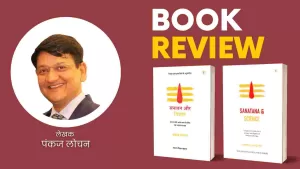
Ankit is a motivated, personable technology & management professional with more than 15 years’ experience in software product development and services space. He has led multi-million transformational programs internationally for some of the marquee organizations in product development, banking, finance, and oil exploration domain. He comes with tremendous experience in executing and completing wide-ranging programs, blended with business and technology of all sizes and challenges. Over the years, he has engaged and worked closely with the customers, solving their problems by playing diverse roles – developer, technology lead, project manager, market researcher, engineering manager, program and account owner.
Akhila Saroha: Before everything else, I would like to congratulate you on the publication of your book, “Cacophony to Symphony.” How has the response to the book been so far?
Ankit Khemka: Thank you very much, Akhila. Thank you! The response has been tremendous. The feedback is positive. The readers can relate with the book as it contains practical examples and scenarios and effective ways to implement them in their software development journey.
Akhila Saroha: What were the events and incidents which inspired you to write a book on software and the loopholes left while catering to customer needs?
Ankit Khemka: I have been working in the IT Software industry for almost 16 years now. I have got the opportunity to work with varied clients and companies. Software development is a chaotic ecosystem. It is never smooth. You face varied challenges and problems. While working with customers, different products, and teams, there were multiple instances where we would have no clue on how to proceed, what to focus on, and in that bid, we lose customer focus. That’s where I thought of coming up with a book that talks about live and real examples and scenarios and the steps that can help teams and the leader to maneuver smoothly. Typically, most of the technology management books are very theoretical, and we hardly implement those concepts in the actual software development. Hence, the need for a practical reference was a must. I thought it would be an excellent opportunity for me to contribute back in a small way to my tech tribe.
Akhila Saroha: In literature, the opposite of cacophony is euphony. Yet you chose to title your book, “Cacophony to Symphony”. What is the story behind that?
Ankit Khemka: haha! Good question, Akhila. Well! Euphony is a way of pronunciation that is pleasing to ears, which is the outcome for the music listeners. It is possible only if the instrument players are playing in a well-structured and a harmonized way, in a symphony. This is a crucial step. You know what I mean. Euphony can be achieved only through symphony.
In the same way, this book talks about the chaos and the discord that we face daily in our product development space. The objective is to transform this chaos to order, discord to harmony, so that each player/software engineer is focussed entirely to build a solution that will solve customer problems. In the end, that is what matters, right 😊
Akhila Saroha: Do you think the standards of technology in our country match the standards of other countries?
Ankit Khemka: India has a big pool of talent when it comes to software and technology. Our software engineers and technology professionals are shaping and leading many companies across the globe. India is the de-facto software development hub and choice for even the developed economies due to its vast talent pool and adaptiveness to new and rapidly changing technologies. We are building software at par with global standards that are being used worldwide. With such an enormous user base of the technology, within India itself, the technology leaders are well-versed with the challenges that a new software may face, and they proactively solve those problems before releasing it to their customers. On top of this, there are marquee institutes and training hubs, where our future engineers are groomed at a different level, to excel in the computer science space.
Akhila Saroha: How much of a challenge was it for you to write a book which everyone could easily understand and avoiding the technical jargon as far as possible?
Ankit Khemka: It was challenging; it was tough. It took me almost three months to firm up my mind to write. I spoke to my seniors, friends, colleagues, researched, but one thing was always clear to me that if I must write anything, it will be related to my engineering, my domain of work and experience.
Also, the book should not contain any hypothetical scenarios; instead, it should be a practical reference so that the readers can relate and implement it on the ground. After writing a few pages, I use to read it myself multiple times to see if I can relate to it from a reader’s mindset. It was indeed a gradual process, but I thoroughly enjoyed and loved it. I have tried my best to keep all the chapters mutually exclusive of each other, but at the same time, they knit a story, if you read them in sequence.
The paragraphs and topics are succinct, to the point. Some topics that can be of interest to any professional outside the software industry are also part of the book.
Akhila Saroha: Have you been reading present-day writing? Is there any author you have enjoyed reading?
Ankit Khemka: Yes, I do, but only technology and management books. I like to read books by Eric Ries and Nir Eyal.
Akhila Saroha: You have the potential to write a lot more. Please share a little about your future projects.
Ankit Khemka: Frankly, Akhila, I have not thought about my next one yet. I just focussed on completing this book and then take a break. But thanks to this pandemic lockdown, I cant move out of my house, and my break is still due. Haha! Currently, I want to listen more from my readers on their feedback and review on the book. 😊 I will start on my next book soon though, post my break. 😊
Akhila Saroha: If you were to assign a genre to your book, what would it be?
Ankit Khemka: Technology and Management in Software Engineering space
Akhila Saroha: What are your views about the present-day writing?
Ankit Khemka: This is my first book, and I had my own set of doubts and apprehensions during the entire journey. I had never got an opportunity earlier to explore the writing and publishing space. It was an eye-opener for me. There are so many platforms available for aspiring authors. I also see titles getting published in good numbers, which is great. I generally read books related to technology and my space. Few authors articulate and convey their thoughts in such a seamless manner that the readers don’t even realize, and the idea is embedded in the mind. I prefer to read such books which are concise to the point and direct in their message.
Akhila Saroha: Do you have any plans to try your hand at fiction writing too?
Ankit Khemka: I would love to write something fictional, but currently, no plans 😀
Akhila Saroha: How do you think an average reader can be most benefitted by “Cacophony to Symphony”?
Ankit Khemka: Cacophony to Symphony is a step by step guide to transform the software product development shop from chaos to order, from discord to harmony. It walks you through the proven techniques to build software in a much simplified and efficient manner by mitigating, maneuvering through the uncertainties and complexities of the software ecosystem.
The book plunges in the crucial facets of software engineering voyage, that are typically overlooked in a rush to create and deliver products faster. It serves a single point of reference for anyone who plans to venture in a start-up or set up a product development garage from scratch. It is also useful for the small and medium-sized product companies aspiring to shift gears and grow exponentially with better market relevance and sustenance. The book offers you with the fundamental blocks along with its right placement to build a seamless product manufacturing system through standardized processes, best practices with customer-centricity.
The engineering, project, program managers, and aspiring software professionals will find this book as a ready reference for their encounters and queries on software development and program execution from concept to delivery.
Akhila Saroha: What would you say about the other books being written today, which are of the same field you belong to?
Ankit Khemka: As I said earlier, they are too theoretical. There are few books thought which are quite insightful. But, with the attention span diminishing and reading, becoming esoteric, the readers, specially in our tech community, want quick and relevant dosage of information, small capsules of data and insights, which is easy to absorb and quick to implement. We, as authors, have the responsibility to write content in such a manner that it grips our readers and is usable in real-world scenarios.
Akhila Saroha: I wish you the best for your projects in the future. Thank you for sparing your time.
Ankit Khemka: Thank you very much, Akhila, for having me here and providing me a platform to share views on my book.
Book Title: Cacophony to Symphony
Author: Ankit Khemka
Interviewed By: Akhila Saroha



